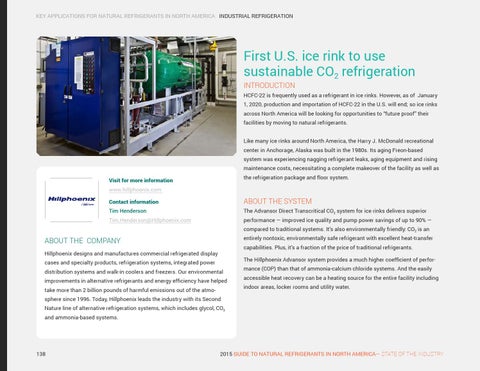Key applications for natural refrigerants in North America Industrial refrigeration
First U.S. ice rink to use sustainable CO2 refrigeration INTRODUCTION
HCFC-22 is frequently used as a refrigerant in ice rinks. However, as of January 1, 2020, production and importation of HCFC-22 in the U.S. will end; so ice rinks across North America will be looking for opportunities to “future proof” their facilities by moving to natural refrigerants. Like many ice rinks around North America, the Harry J. McDonald recreational center in Anchorage, Alaska was built in the 1980s. Its aging Freon-based system was experiencing nagging refrigerant leaks, aging equipment and rising maintenance costs, necessitating a complete makeover of the facility as well as the refrigeration package and floor system.
Visit for more information www.hillphoenix.com Contact information
ABOUT THE SYSTEM
Tim Henderson
The Advansor Direct Transcritical CO2 system for ice rinks delivers superior
Tim.Henderson@Hillphoenix.com
performance — improved ice quality and pump power savings of up to 90% — compared to traditional systems. It’s also environmentally friendly: CO2 is an entirely nontoxic, environmentally safe refrigerant with excellent heat-transfer
ABOUT THE COMPANY
capabilities. Plus, it’s a fraction of the price of traditional refrigerants.
Hillphoenix designs and manufactures commercial refrigerated display
The Hillphoenix Advansor system provides a much higher coefficient of perfor-
cases and specialty products, refrigeration systems, integrated power distribution systems and walk-in coolers and freezers. Our environmental improvements in alternative refrigerants and energy efficiency have helped take more than 2 billion pounds of harmful emissions out of the atmo-
mance (COP) than that of ammonia-calcium chloride systems. And the easily accessible heat recovery can be a heating source for the entire facility including indoor areas, locker rooms and utility water.
sphere since 1996. Today, Hillphoenix leads the industry with its Second Nature line of alternative refrigeration systems, which includes glycol, CO2 and ammonia-based systems.
138
2015 GUIDE TO NATURAL REFRIGERANTS IN NORTH AMERICA— STATE OF THE INDUSTRY
